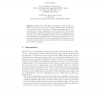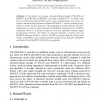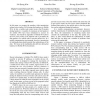MWCN
2004
Springer
14 years 4 months ago
2004
Springer
In Mobile IPv6, each packet sent and received by a mobile node contains its home address. As a result, it is very easy for an eavesdropper or for a correspondent node to track the ...
ISW
2004
Springer
14 years 4 months ago
2004
Springer
Security problems in micro-mobility are mostly related to trust establishment between mobile nodes and middle-boxes, i.e. mobile anchor points. In this paper, we present a secure m...
ICCSA
2004
Springer
14 years 4 months ago
2004
Springer
Mobile IPv6 enables mobile node to roam transparently in any network. It shows good performance for macro mobility but it is not proper for supporting micro mobility because of lar...
ICOIN
2005
Springer
14 years 5 months ago
2005
Springer
Abstract. Mobile IPv6 is the IETF proposition to support host mobility in the Internet. It provides routing optimization for packets sent to the mobile node at the expense of signa...
ICCSA
2005
Springer
14 years 5 months ago
2005
Springer
In this paper, we propose internetworking strategy of WLAN and MANET. Both WLAN and MANET are based on IEEE 802.11 for MAC layer protocol while they adopt different mode, such as i...
MOBICOM
2005
ACM
14 years 5 months ago
2005
ACM
In this paper we investigate the benefits of a heterogeneous architecture for wireless sensor networks composed of a few resource rich mobile nodes and a large number of simple s...
WONS
2005
IEEE
14 years 5 months ago
2005
IEEE
Due to the mobility of nodes in Ad hoc networks, network topology is dynamic and unpredictable, which leads to frequent network partitioning. This partitioning disconnects many no...
CONEXT
2006
ACM
14 years 5 months ago
2006
ACM
While the IETF standardization process of the Mobile IPv6 and Network Mobility (NEMO) protocols is almost complete, their large-scale deployment is not yet possible. With these te...
ICMCS
2006
IEEE
14 years 5 months ago
2006
IEEE
In this paper, we propose the seamless video transmission scheme over wireless LANs during fast handover in Mobile IPv6. In fact, a mobile node cannot receive the IP packets durin...
OTM
2007
Springer
14 years 5 months ago
2007
Springer
Abstract. Recent contributions have uncovered the potential of network coding, i.e. algebraic mixing of multiple information flows in a network, to provide enhanced security in pa...



